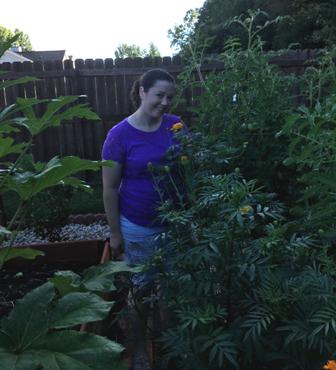
Marigold
Marigolds are the perfect trifecta plant. They are a good companion plant, pest repellant, and trap crop! They come in a good range of colors and heights!
Tall ones are excellent for planting with tomatoes and not getting overshadowed. And shorter varieties are good for everywhere else in the garden that has a need for pest management. They are, in my humble opinion, a must-have flower for any garden!
|
T. patula nana–Gypsy Sunshine T. patula: Burpee’s Best; Orange Flame; Red Knight T. erecta: Climax Mix; Mission Giant Yellow; Orange Flame; Sunset Giant |
|
Tagetes erecta Tagetes patula |
|
Intermediate to start from seed Easy to grow |
|
Easy |
|
4 years if properly stored |
|
Annual |
|
3-14 days Prefer bottom heat to germinate |
|
None |
|
1/8 – 1/4 inch |
|
|
|
Full sun |
|
|
|
February, March, April, and May |
|
Yes |

Growing Tips




Tagetes spp.
When to Start
Start indoors: 7-8 weeks before the last frost date. (Mid-Feb – Mid-Mar for Jefferson, GA)
Transplant: In after the danger of frost has passed and after hardening off. (May 1 for Jefferson, GA)
Direct Sow: After the danger of frost has passed and soil temps have reached 65-75 F. (May 1 for Jefferson, GA)
Start Indoors for Trap Cropping. Start soon enough so that the plant is blooming at the time the pests you are trying to contain arrive.
How to Start
Intermediate to start from seed, easy to grow after germination.
Marigolds like warmth to germinate. Soil tempseraturs should be between 65-75 F. You can place them on the top of the fridge (as marigolds don’t need the light to germinate) or purchase a seedlings heat mat. Just make sure you get a water-resistant one and read the instructions carefully.
Start indoors 7-8 weeks before the last frost date. Sow to a depth of 1/8 – 1/4 inches deep into sterile seed starting mix. Place them on a heat mat and place under grow lights. Transplant after hardening off and all danger of frost has passed.
Typically, marigolds will take three to four days to germinate but may take a few days longer if the location is cooler.
Care
Plant in full sun. Thin to 9-12”. Dead-head plant to encourage more blossoms until you are ready for it to go to seed. Flowers bloom in mid-summer and are good-cut flowers.
Pest Management
Marigolds have other beneficial uses than just culinary. They are the perfect trifecta plant. Marigolds are a good companion plant, pest repellant, and trap crop! They are, in my humble opinion, a must-have flower for any vegetable garden!
How to use
Both the African marigold (Tagets erecta) and the French marigold (Tagets patula) are edible. That being said, not all Tagetes spp. taste the same. Tagetes patula is reputed to have the best flavor.
Marigolds (Tagetes spp.) complement both sweet and savory dishes and can be eaten raw or blanched. Marigold petals are called poor man’s saffron. The petals can be used just like saffron.
My personal experience
I will always plant the wunder flower! It does so many good things, it will be planted every year. I always interplant it in between my tomatoes. It helps repel root-knot nematodes and attracts beneficial predators and pollinators. And, it acts as a trap crop for Japanese beetles just to name one.
I grow tall marigolds in between my indeterminate tomatoes and shorter ones in between the determinate tomatoes. This way no one is competing for sunshine. I do have to steak the taller ones. You can see my 5 foot tall ones in the picture to the right.
I find them easy to grow if bottom heat is applied. I start them indoors each year and transplant them at the same time I plant the tomatoes. As I’m planting them for a purpose, I want the extra head start so they are blooming as soon as possible.
Saving seeds is easy. And they are prolific self-seeders. There are volunteer seedlings every year. They do have an odor that you either love or hate. Insects also feel this way, but that what makes them both a repellant and an attractant to various insects. For more, see my 4 must have flowers.

Seed Saving

Isolation Distance
Insect dependent for pollination. Isolate 1/4 mile to prevent cross-pollination.
Instructions
Select healthy, robust plants free of any signs of disease or insect infestation for seeds. Seeds carry the traits of the parent plant. Choose plants that exhibit the traits you wish to preserve. Consider bloom size, color, and shape, as well as blooming time.
Allow the biggest and healthiest blooms to mature on the plant. Cover the seed head with a fine-mesh bag as soon as the flower petals shrivel and die. Use an elastic band to hold the bag in place. This prevents seeds from spilling onto the soil before harvest.
Clip the flower head from the main stem once the seeds are dry and dark. Or wait until the seed head bursts. Separate plant debris from the seeds by removing the mesh bag and placing the flower head in a paper bag and shaking to loosen the seeds. Seeds settle to the bottom of the bag. Remove plant debris by hand.
Features
- Attracts pollinators
- Attracts hummingbirds
- Deer resistant
- Drought tolerant
- Low maintenance
- Good cut flower
- Container friendly
- Both the African marigold (Tagets erecta) and the French marigold (Tagets patula) are edible. They complement both sweet and savory flavors. You can eat them raw or blanched. The petals can be used as a saffron substitute.
- Burpee’s Best: Double blooms in shards of gold, orange, and red.
- Climax Mix: Long-lasting ruffled blossoms appear midsummer and continue until frost.
- Gypsy Sunshine: Heirloom. Dwarf, bushy plants produce yellow blooms. Excellent for beds, borders, and containers. It is a natural food and fabric dye.
- Mission Giant Yellow: Heirloom. The double blooms are 3 inches and lemon yellow.
- Orange Flame: Heirloom. Dwarf plants produce bronzy red to orange blooms.
- Red Knight: The blooms are deep red mahogany and gold. Good for beds or containers.
- Sunset Giant: Heirloom. This marigold was prized by the Aztecs 1000 years ago. Blooms are 5 inches plus across and come in orange, gold and lemon yellow.

Marigolds are the perfect trifecta-the Wonder Flower! Marigolds are a trap crop, and companion plant, and they repel nematodes!
They are a good trap crop because some pest insects (e.g. Japanese beetles) are more interested in the marigolds than your vegetables. Plant them near problem areas.
Marigolds are a good companion plant as they attract many predators, which will eat the pest insects.
And they repel nematodes, which like to eat the roots of plants, like tomatoes. Plant them intermixed with tomatoes to help keep the roots healthy!
They are a MUST for any garden, especially if you are trying to grow organically!
Dried marigold flowers are a poor man’s saffron. Just dry the whole flower head and once dry remove petals and use as saffron.
You May Also Like:
Must have flowers for your vegetable garden!
Tomatoes love Marigolds! 12 tomato planting hacks
Companion Planting: How to use flowers to help control pests.
Trap cropping: How to keep pests out of your main crop
Sources:
Gardenguides.com
Starting & Saving Seeds by Julie Thompson-Adolf
Edible Flowers: How, Why, and When We Eat Flowers by Monica Nelson
